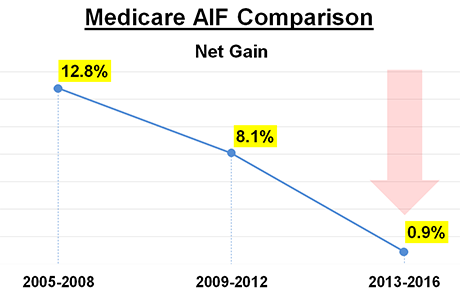Reimbursement Reality Check
The Good Old Days!
Remember back about ten years ago when we got those really nice Medicare increases each year?

We remember! One year 5%, another year 3; it sure was nice and it helped us keep up with the rising costs of everything that makes our EMS agencies go. With Medicare comprising as much as 50% or more of the total dollars that we all realize in most cases, the important additional dollars each year helped keep vehicles on the road and supplies in the cabinets.
Enter the Productivity Adjustment
Then came the “Productivity Factor” in 2011 and things changed drastically.
Allow us to explain. Prior to 2011, the National Medicare Ambulance Fee Schedule was computed based on the Consumer Price Index for Urban Consumers (CPI-U) which formulated into an adjustment equation called the Ambulance Inflation Factor (AIF). Basically mirroring inflation in the calculation, the adjustment would always be positive or just no adjustment at all, but the fee schedule payment amounts never decreased.
The calculation was factored in at the turn of the calendar each New Year.
When Congress imposed the Multifactor Productivity Index Adjustment (MFP) into the equation, suddenly there was a “correction” factor and also for the first time ever there was the possibility, if inflation was negligible, that we could actually see a decrease in the Medicare dollars we receive one year to the next.
The theory of the MFP which is computed using a 10-year moving average of the changes in private, non-farm business, is to factor in what the Federal Government sees as an efficiency factor. This means that although our costs may be rising, the MFP somehow also mirrors how much more efficient and cost-effective we’ve all become in EMS and offsets the CPI-U essentially cutting into and balancing out the potential increases.
A Picture’s Worth a Thousand Words
This blog space is a word space. But, in this case, we believe it will be more effective to show you a picture of what the introduction of the MFP has meant to our bottom lines over the years. We graphed the AIF in 4-year increments for the last dozen years and the resulting pictorial representation is startling.
In the 3-year period encompassing 2005 through 2008, the combined increase in Medicare dollars came in at 12.8% over the period. The period 2009 through 2012, which picks up the 2011 MFP introduction, shows the beginning of the end of the health adjustments as the increase for that period dropped by a combined 4.7% to 8.1% aggregate for the span.
But just look at what happened over the last 4 years taking us right up until today!
For 2013 through 2016 Medicare dollars have not even gained a combined full percentage point*. Of course, part of the reason for that decline is this year’s -0.4% decrease.
This current calendar year’s adjustment saw the AIF fall for only the second time ever by four tenths of a percent which was arrived at when the CPI-U came in at a stagnant 0.1% offset by a 0.5% MFP which is deducted and therefore sending the AIF into red-ink territory.
Is it any wonder as we watch the price of career staff wages and benefits spiral, equipment costs increase and just overall upward adjustments in just about everything we do in EMS that we all feel like we’re spinning our wheels?
Add to that…
Of course add to that increasing insurance deductibles ushered in by the effects of the Affordable Care Act on everything healthcare in America and it’s becoming increasingly difficult to stay ahead of the game.
Everybody in EMS is in the same boat. It all means that we must work smarter and do everything we can to collect every last dollar. Forgive the infomercial here, but this is why we are high on the abilities of outsourcing your ambulance billing program to professionals that can help you navigate these increasingly rough waters of reimbursement.
While we can’t control how you spend the money you make, a good billing outsourcer like our office here at Enhanced Management Services can help you stay abreast of the changes and move quickly to forecast and adjust to what’s coming!
